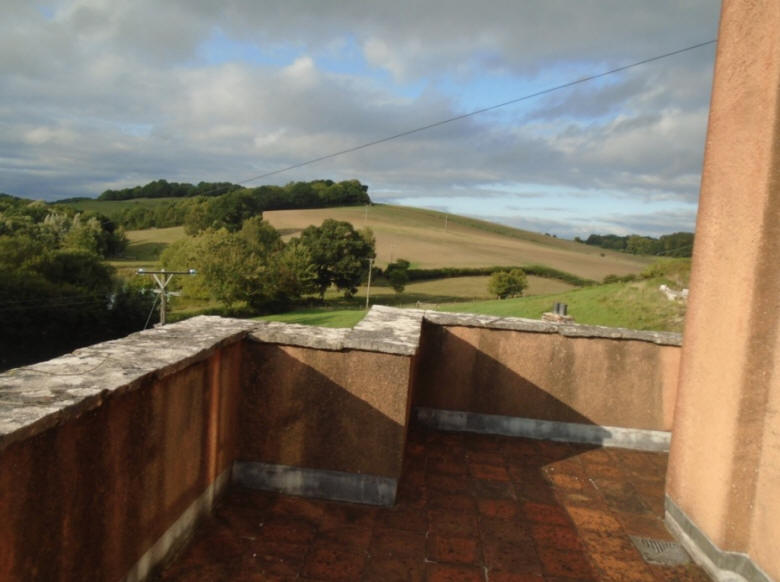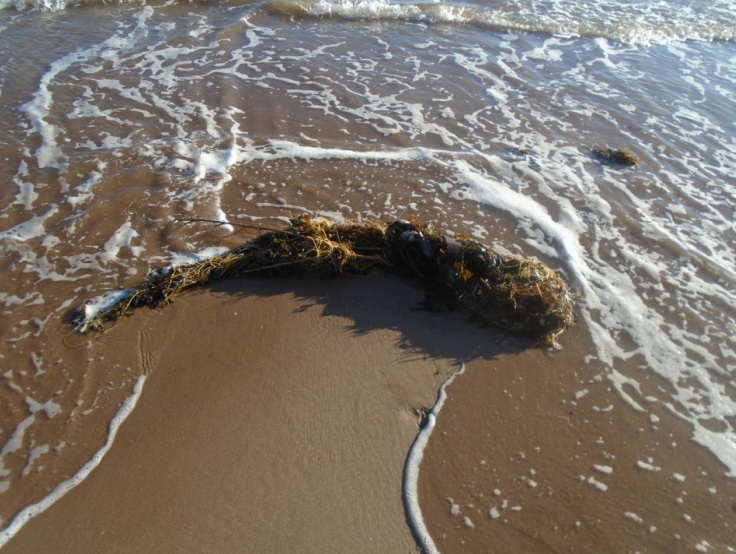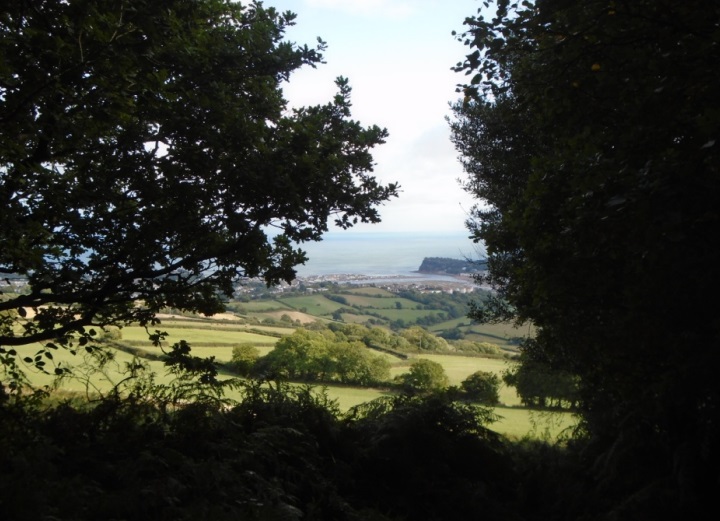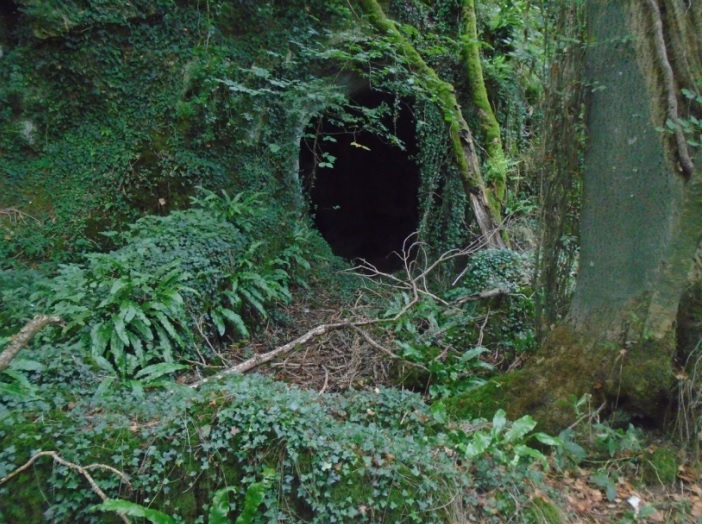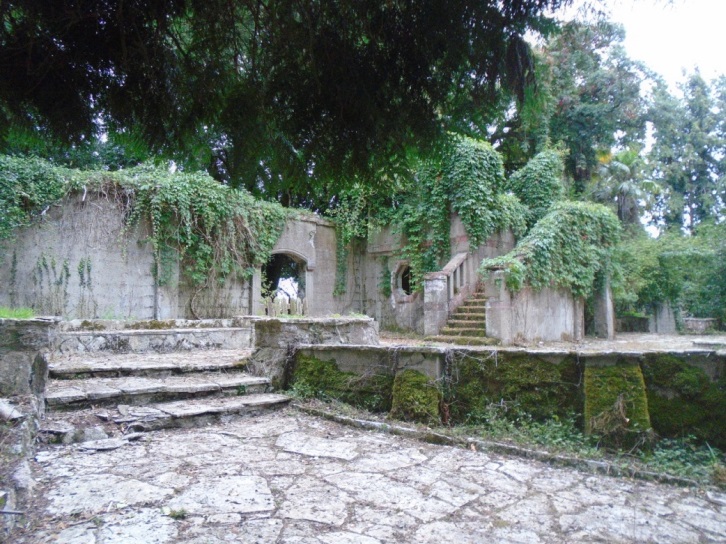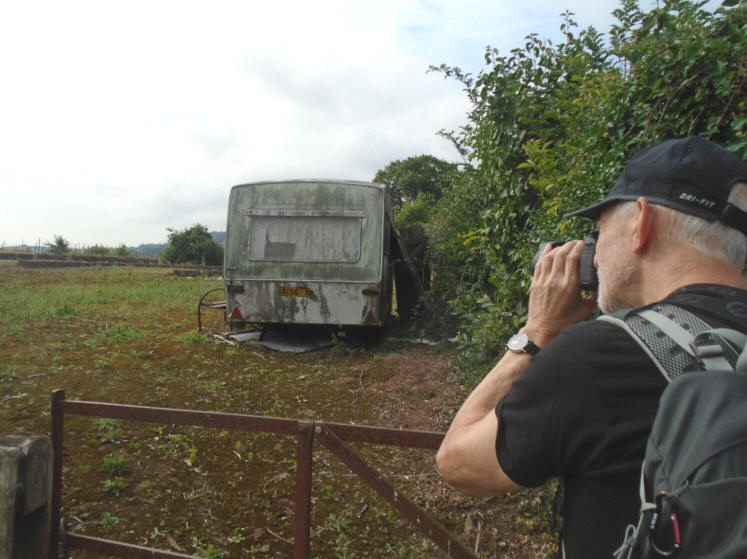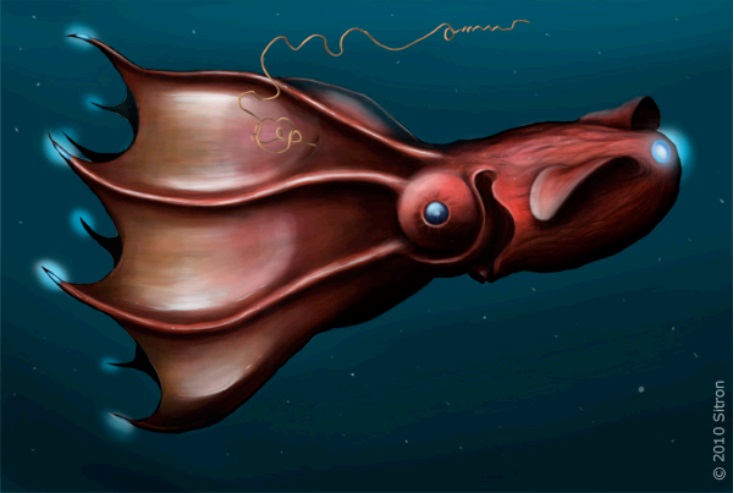|
|
| home | exhibitions | interviews | features | profiles | webprojects | archive |
|
Theory after Lovecraft: a warm cosmicism Tony Whitehead and Phil Smith
In the light of this recent elevation of Lovecraft’s weird fiction to critical-theoretical and cultural touchstone, we set out to use Lovecraft’s fictions as a sensory guide for unpicking the local landscape of his ancestors; which was part of our local landscape and which, we speculated, had continued through family traditions to play a part in Lovecraft’s art. Walking the lanes and fields, hills and odd architectures of this ‘Triangle’, we interpreted, finessed and rejected. We looked for his monsters.
At the same time, in response to Lovecraft’s cold and unforgiving universe fuelled by his own deep fears of ‘the other’, we walked and talked our way to a warm cosmicism. We took from his mythos the overawing scale of its cosmos and its entities. We were equally unnerved as his characters by what the depths of our own planet could bring forth and by whatever the seas of some far distant oxygen-superrich planet might right now be unfurling. However, we found neither Cthulhu, Azathoth, Shoggoths nor any other related and supposedly eldricht horror to be evil or malevolent; indeed we came to propose them as not entirely different from ourselves, not entirely unreachable, never entirely distant. Following the arguments of Vilém Flusser
and Louis Bec in their Vampyroteuthis Infernalis (2012), we
celebrated a common ancestor with the monsters; all together (Cthulhu,
Shoggoth, us) subject to the same attraction to each other, gravity and
desire. We expect to fear these things and to be overwhelmed in their
presence, for even in the quiet lanes and on the wooded hills of south
Devon there lurks a fanged and horned sublime, but that does not make
the alien our enemy, it does not make the wolf our likely 3
Every place is connected by routes and trajectories, by how they sit and slide across planes and fields. Commercial connections are fine for the safe transport of goods, arriving in pretty much the same state as they left, but there is another kind of commerce by which traders, goods and stories are transformed in and by the journey. It was these travels, never escaping states of unbecoming on departure and becoming on arrival, which interested us. So what do we mean by ‘places’? Places are everything, surely? Everything is in, arriving at or departing from some place? Equally, places are not separate from all the things in them; the organisms we popularly grant agency to (foxes, swallows, slugs and other humans) and inanimate agents like mud slides and floods and viruses. All such things make a place (you don’t get a plague village without a plague), including the weird stuff that falls somewhere between organic intelligence and inorganic inertia, like sprung verse and slime mold. Ours is not just the cartographic view of place, with a layout connected by lanes and roads and phone lines and sewers. The matrix, the grid onto which we impose meaning. Instead, a territory also stands up and means back at us, can manipulate us like fibbing Pinnochios in three and four dimensions. It can render us altered by the dance of points of view it affords, theirs and ours, held in orbits by desires and attractions, each one for each other. Within The Lovecraft Triangle, Denbury Hill is framed by the cave mouth of the Old Grotto near Torbryan in the valley below. Yet from the top of Denbury Hill, the cave is not visible. With each shift of viewpoint, there is a change of matter; viewed and viewer are connected and then disconnected. The geography makes each thing – cave, hill and human witness – other than what they previously were; their discrete identities and their open relations are unpicked each time by the particular relativities of a place. This may be why there is no object (in the sense of outcome or destination) in the psychogeographical dérive; some version of which we deploy in our hypersensitised walking. It’s all a play of subjects with no object or outcome. Once we give up the human exceptionalist super-eye, the ‘backdrop’ and the ‘scenery’ step forward as the stars of the show. The walker becomes witness to the unhuman drama. At each moment in our destinationless walks, with the possibility to loop backwards or forwards, a new relation of things to each other becomes possible; and a new relation within each thing. The walking transcends ‘one step at a time’ to become a surge of fascia; a walking surface or sheet of tensing and relaxing gristle. Similarly with the shift of viewpoints or the rearrangement of relations; these are not airy notions, but cartilaginous switches. Our places seem to like us being there, BUT … this is only one of any number of texts that might be written by or about these places; we are lazy amanuenses.
Places in four dimensions change in time; a cloud passes, the tide departs glacially, fault lines grate. Alternatives to these narratives are curled up in tiny dimensions within a consensus reality. Our cave near Torbryan is a reef, home to Nautilus, and there in the same ‘place’ also a home to the hyena, and again a sanctuary for the eccentric Victorian palaeontologist James Lyon Widger to desert his job in a drapery shop to drop down into the darkness and dig out the hyenas’ teeth. All of these times are present in the same place.
In the fifth dimension are all the places made by our memories of childhood television, our adult obsessions, or just our mood. These are not made up of sociological data, but of representations that have their own individuated and autonomous being. This is the bright reverse of Guy Debord’s Society of the Spectacle – all societies are contradictory – for though the substitution of things by images has been a catastrophic alienation, the upside is that these representations can be recognised for their agency; parts of an endless layering of instances, each curled up inside tiny dimensions on the surface of ‘normal’. Some of these images worming their way into reality are invisible, others are affective, all of them are effective; agents sometimes only detectable in the ambience and atmosphere of a place, interacting with the intuition of a sensitive walker. Any such moment of engagement is wrapped and rolled around others; always on the point of tipping itself and other things into seething plasma. Robert Anton Wilson might have called this ‘chapel perilous’, the no-person’s-land where the supernatural and subjective imagination wear each other’s clothes. Lovecraft might have called it Azathoth, “that amorphous blight of nethermost confusion which blasphemes and bubbles at the centre of all infinity” and “the monstrous nuclear chaos beyond angled space”. But we have cut the planets free from the sun in their orrery, and we posit no order or disorder that might have one name. Instead we have come to celebrate the mad love of many stars for each other; rock and roll or Andromeda. There is no nucleus in these galaxies; their parts are their relations; what Karen Barad calls “intra actions”, relations that are meaningful, active and independent. Unlike interaction that has separate pre-existing things bouncing off each other, yet always retaining some adamantine core beyond their relations, these intra-actions are the constant and indivisible flow of things changing things changing things in constant relationship.
The cosmos is uneven. It does not cancel
itself out by an equivalence of matter and anti-matter; matter prevails
and lives and grows by contradiction. It has being only by imbalance. A
‘harmonious’ universe is one that would never have existed in any sense
we can understand; a human being distorts themselves and damages their
world by seeking an ideal, peaceful or benevolent form to their
relationship with the universe. The warmth of our cosmicism does not
extend to sentimentality.
What may appear at first to be dogma may
turn out to be poetry. A person pushing their orthodox faith too far can
run into a wonderful eccentricity. A traditional image dressed up in
vivid local colours can uncover a new locatedness and through that a new
and contradictory being at loggerheads with assumptions. “Shall we do the same next year?” a woman asked a Druid in Woodhenge. “No, if we repeat, it’ll become dogma.” In resistance to universalisms we arrived via our interest in birds at the idea of ‘fields’ as some kind of spacing of everything to keep returning to; that’s ‘fields’ in the metaphorical sense. We drew on developments in quantum biology in relation to the navigation of European robins, who experience the collapse of quantum super positions in the tissue in their eyes as chemical reactions that colour their sight in different shades of blue dependent on their orientation to the nearest planetary magnetic pole. They navigate by the blazing colour coding of their senses. We seek an analogous coded sensitivity to
unseen but real forces and patterns in the landscape, based on
precarities (as an equivalence to unsustainable super-positions) and a
non-causal, probability-based connection to the wider context. The
landscape in its precarity is always many things at once until the
navigator arrives, much as quantum systems are probabilistic before they
are measured. Thus, we walk with many, many ideas at once. Everything in
its precarity always on the edge of collapse; trying to observe without
measuring; intuit the varieties without collapsing them into classes. In Bonelines, we plaited a number of malicious strands of universalist thinking – from an early transhumanist drive for singularity to the racist Beyondist social-evolutionism of the psychologist Raymond Cattell – in the fictional form of the ‘Hexameron Society’. Our anti-universalism is not an animosity to theory or philosophy per se. The opposite is true; our overarching idea is that we walk with a multiplicity of ideas in motion about each other and learn more from the relations between different systems than from the systems themselves. The landscape, author, text and reader are entangled. And the outcome is unpredictable. That’s about all we are sure of. We, the authors, may have a point, at times, but this is fragile. And we certainly do not seek to make this point; only to be blunt about it.
The ‘spirit of a place’ is often misrepresented as a vague ambience, a dimly or strongly felt atmosphere, something separate, just as a mind is often presented as different from a body, and as a soul is presented as different from, and superior to, them both. But what is genius is material. In classical period Rome, from where the term comes, the genius was individuated and magico-material; a personal place-being. Not a concept, but a character, a personality. To embrace such a discrete agency, but
skirt its anthropocentrism (for the genii are defused when reconfigured
as the folk next door), we recognise the agency of the genius without
imagining it to be human-like. We recognise it acting, doing and
performing as an uncanny personality.
How a genius loci expresses itself (and now
start thinking about how an atmosphere is an agent) is in loss, in the
failure to sustain all possibilities, settling for a glorious
probability. The precarious materi ality of the genius, pulled by all
the things that come within its reach, is not absent in its
discreteness, but is like the wave that feels for the submerged beach
and then trips on the bottom and breaks into meaning. Hyena, cloud, car,
rain, camera lens, Nautilus – these are all suspensions of infinite
possibility until they magnificently surrender to entropy, resolution
and the dynamics of being and dying. For all this, whether pebbles or genii, is withdrawn from us.
‘Withdrawn’ in the sense that the OOO philosophers have it; in the positive sense that each thing, by the discreteness of its being a thing, pushes back against a connection that always threatens to translate it into convention or conformity. Things, in relationship with us or with myriad other things (they intra-act), are never exhausted by these relationships (their being is always withdrawn); things are things and yet ever becoming. Just as fragmentation and separateness (which Debord saw as the guiding malevolence of the Society of the Spectacle) and the idea that the “thing in itself” is defined alone by its unique qualities feed positivism direct to commodity fetishism and alienation, so there is also a trap set in what appears to be their opposite: hyper connectivity, that everything is defined by its relationships and everything is connected. For rather than multiplicity, which is a mass of withdrawals, there is a threat in oneness, in holism, in subjugation of the organs to the organism (the bio-totalitarianism that is resisted by the misnamed ‘Body Without Organs’) and then, and here’s the problem, in transcendence beyond complex and messy things to the ideal. For even where there is ‘plasma’, where difference is undone in energy, there is still disruption, verfremdungseffekt, the uncanny challenge to wholeness, ideal and holiness (which should always have something obscene about it). The universe is never completed or resolved, never ideal; place, as Doreen Massey persuasively argued, is always under construction.
To butt in on ourselves….
Once begun, base your studying on both anomalous and non anomalous data. Reject nothing. Welcome everything in; then weave a unique path through the data. Avoid those paths within the frames of information that confirm the established ‘truth’, unless the evidence forces you back onto them. First, assume the absurd; then test it. Open the doors to what Charles Fort called “damned data”, those verifiable and empirical bits of evidence that do not fit accepted narratives. Do not be afraid to propose the most complex and esoteric of explanations and then walk back from them without shame, on the basis of evidence. Choose a difficult place to start from.
We seek to make ours an immersed being-in-the-world, giving attention to the affects of being ‘at the mercy’ of the routes we take. The route is the author of our journey. There is no need to separate this hypersensitised presence from everyday life (such separations can have negative effects on the closest of relationships); ‘just being with’ is as legitimate in a supermarket car park as at the Taj Mahal or within the circle of Stonehenge. Our ontology is flat. Everything is equivalent. Reject nothing. A couple of years ago, together at Stonehenge for the sunrise at solstice, the buzz of a drone, the traffic rumble of the A303, the flashes from the hi-vis jackets of the security guards, the calling of the quarters and the rising of the sun behind the heel stone, and our wondering where we had left our staffs when holding hands in a circle: all of these were equivalent elements of that place and the time; not rejecting any of these is a “being with”.
Far better to be sensitive to how inauthenticity – in fake narratives, unjust appropriations and so on – informs all our presences. Not just in a negative sense. Inauthenticity can be celebrated and embraced. “Just being with” acknowledges this, makes it explicit, is part of the richness of “just being with” and pushes away the temptation to think of “being with” as a cold rejection of past and future in order to “be” in the present. The present is shot through with past and future and their representations. We are not caught in a loop; we are raised up and we acquire depth in a loop. Entangle your presence as a ‘being-in-the-world’ by giving equal attention to the ‘world-in-your-being’; attending to the living presence, in your body, of ‘dead’ matter from the stars and the TV. Attend to that which cannot be known. The universe is dark. It interacts in infinite ways beyond our knowing – ways that are not accessed by the ‘everything happens, nothing changes’ of soap opera – ways we will never know. This is not the matter of horror, as it is discoursed in Lovecraft’s stories; this is the ‘thing’ in celebration. A comfort. In this dark universe, that we may have a lover’s hand to hold is miraculous.
A traumatic colonialism is everywhere elsewhere, and is here Speaking from a ‘First World’ western perspective, we cannot throw off the presence everywhere about us of a traumatic colonial elsewhere/elsewhen that increasing loops back to here and now. Just as Joseph Conrad’s Heart of Darkness cannot unhear the whisper of “the horror, the horror” behind the facades of London terraces, we cannot unsee the recruitment of representations of every ancientness we might want to reverence, of every specificity of every site we might want to acknowledge, to the cause of identity, exclusion, rape and slavery. While all about us are those who are happy, anxious or obliged to sell this history as glorious or unfortunate, to normalise the murder and exploitation of others. All of which goes beyond the first impressions that the word ‘colonial’ may give rise too. Our ‘being-in-the-world’ is contingent and particular, and sensitises us to the presence of an ‘other there’ in our ‘this here’. We do not make our own meaning in a meaningless world, independent of each other. We are shaped in a relation to each other; relation brings obligation.
There is such a thing as society. And it
stretches beyond the human. A society of things of every kind. This hollowness or nothingness – in tune with the understandings of the Kyoto School of Philosophy – has nothing to do with nihilism. In the pessimistic or nihilistic world view there is only gloomy void; a distant and abstracted emptiness, a void born of surplus consciousness that cruelly allows us to see the meaninglessness of our life. A void that proposes non-existence rather than life. This is not the nothingness for us. Instead, we seek a hollowness that is touchable, all around us, a darkness and nothingness that are right there in the terrain and in us, sited and particular, ambient and genial. Given all that, turning to one’s own truth, private death or essential self, all of which are as susceptible to particulate properties as any other thing, is impracticable. They are better addressed as improbabilities, things that exist despite every likelihood, parts of a ‘nothingness’ diffused through a self. In Bonelines, changes are existential; they
are made by and through feeling individuals at the expense of categories
or orders of matter. Mandi, the novel’s central character, takes on her
‘supernatural’ or ‘hypernatural’ form, but then fades back and forth
between this and a more recognisably ‘natural’ shape. Similarly her
three ‘angel’ companions repeatedly slide along a continuum of strange
and unremarkable appearances; while those characters that do not
transform quite so radically, Grant Kentish for example, are physically,
if limitedly, mutable. This is very close to the Buddhist notion of emptiness. Not that there is nothing there, but that there is nothing there that is not entirely dependent on everything else. Which makes it impossible to identify a thing except in terms of its relationships. But we are only ever party to a very few of those relationships, because they are withdrawn, so we can never actually know the thing-in-itself, even though it has discrete being, a name, matter. Graham Harman turns to the arts as a means to better know reality rather than ‘just’ think and philosophise it. Physicist-theorist Karen Barad’s ‘intra-action’, mentioned above, perhaps explains why we have not all succumbed to collective despair in the face of our unknowing; we mostly cobble together a weltanschauung that works for us, skirting (mostly) around those who seek to subject us to a Big Thing-In-Itself to explain all things to us. We may acknowledge the ‘withdrawal’ of the thing and even celebrate its capacity to resist appropriation and conformity to systems, but we cannot pretend to transition from respect to knowing; instead we celebrate the cobbling-together of relationships. Those who espouse a general cynicism or defeatism (or philosophise and weaponise them as a Dark Enlightenment or as transhumanism) as a means to protect themselves from the illusions of hope they fear, put themselves in danger of being eaten by a gloomy nothing, cold-cosmicist and fanged. They fall into the structuralist gap in the conversation; une ange passe and they fall to earth and lose their footing. Lost for words before the sublime, in self-obliteration or addiction, or at the end of a relationship, they reset the status quo; it’s like that tiny gap between the end of a performance and applause, when the performer retreats from the risk of humiliation and returns to complacency. We carry such moments of existential cowardice and bad faith in our being; they are tied into our instinct for survival. Our anxieties give form to a not-nothing, and derive non-form from it: an imagined abyss, a protection against life, a life against being, a bifurcation. This is the work of the ‘great deceiver’; he who for the coin in our pocket will gladly take our being in all its filthy inconsistency and replace it with a safe “not-nothingness”. This is the fraud of the limited choice, the yes or no; the beast with two horns. We are against this particular ‘Satan’; for our deities have many horns including Satan’s.
The presence we aspire to is a work and not a settlement or dwelling. When our ‘being there’ becomes too generative of identity, we seek strangerhood. We are not present to command by learning and gathering. We are there, at the mercy of there; open to being saved and supported by locals. We do not seek ownership of any place, but we may imagine being claimed by it. This is still problematic, generative of identity, limiting to a fuller experience; for wherever we are, even close to home or in the bath, we are the children and grandchildren of colonialists, we are strangers in our homes, pursued by what was, and is, done in our name. We do not start from a neutrality of presence; we are painfully aware of how our privilege obliges us to undo ourselves. But then that’s a piece of cake compared to those navigating the legacy of slavery. Now do you see how specific this thinking is? How limited and unliberated by the gross history we drag along behind us like a huge tangle of congealed garbage? How complicated by the ancientness we connect to? Ancientness is no escape from inheritance, but a means by which to turn around and confront the horror of it. And while we may celebrate the uniqueness of a place, it is never different to the uniqueness of the place next door. There is everything and nothing special about a place; everywhere here is tainted by colonial hubristic violence.
Walking the Lovecraft villages we became aware of at least two large expanses of terrain where there are no Saxon villages with village greens, crossroads and churches – things that ‘should’ be there in an English countryside – but where instead there are isolated homesteads, at most small clusters of dwellings. These are the spaces that cohere to the ‘isolation’ in Adam Scovell’s folk horror definition: “long roads, endless fields... devoid of people”. For us, however, the eerie atmosphere of such a terrain is loaded not with folk horror, but with the sense of a very faint alien and inspirational past; one that might collapse at any moment into something fixed and real and partial. The two large expanses in question lie below significant Dumnonian ‘monuments’; one on Denbury Hill and the other on Mamhead Hill. Dispersive use of land with families living in small groups, resistant to the creation of concentrated communities, is characteristic of the Dumnonii. They lived in these areas for centuries prior to and during the Roman invasion and were still a definable community a thousand years later when a community of ‘Britons’ was expelled from a suburb of predominantly Saxon Exeter by King Athelstan. The Dumnonii did not resist Roman invasion, living peaceably – but separately – alongside the Romans (and, similarly, later alongside Saxons); unlike other tribes they did not have a currency, did little to exploit natural resources to create surplus wealth, did not build ‘forts’ (as nineteenth-century historians with colonial assumptions labelled them) but sites that make more sense as places for meeting and negotiation than conflict and defence. Their artwork is mostly non-representational and it seems that they had a religious practice connected to small landscape features like groves of trees, springs and streams. They did not build temples. When the Romans left, 350 years after their invasion, the Dumnonii were still building the same design of huts (often on the same foundations) as when the Romans arrived. They did not occupy the abandoned colonial city of Isca (Exeter) when the Romans deserted it; you can take that, according to the ideology of Progress, as the dullardism of primitives, or you can take it that they just knew they had a better thing going on. (Though even they couldn’t eventually resist Christianity; which, unlike the Romans, insisted on the subjugation of local deities.) We are prepared to speculate that the
resilient, dispersive, non invasive living of the Dumnonii is still
observable in the shape of the contemporary landscape of parts of south
Devon, and that the particular qualities of its cultural aufhebung
(what remains of the effects of its disappearance) are intuitable in
some obscure artefacts of what is now culturally identified as ‘eerie’,
and endowed with a gentle ‘terror sublime’, including some of the rural
landscapes that crossed the Atlantic and reemerged, via family stories
of the ‘old country’, in H. P. Lovecraft’s tales.
Dumna Attend to the deep within and the deep
without, the nothingness deep inside and the darkness far below. In the Lovecraft zone our new mythos goes
something like this: the magical landscape of the Dumnonii, a people who
lived non invasive, sustainable and dispersed lives with attention to
small natural features, is still there. It can be wandered, reverently
but unceremoniously, with attention to its pre-meaningful forces, to
their thing-power, sensitive to their specificity over universalist
interpretation, attending to the faint resonance of a ‘personality’ in
the place.
The privileging of anomalies Deploying a method of Charles Fort’s – prioritising the anomalous over the empirically certain – has highlighted for us the crucial significance of random mutation and how, though we might seek to capture and frame inorganic objects and their representations, they never stand still. They are repeatedly subject to a sudden mutability which can jerk them from their context. Erosion then reduces a whole to a part, a separation sees a further part float free and assume an independent significance. We have not been looking for intention or meaningfulness in these crossings of categories, but rather by insisting on mutation’s resistance to universal meaning or intelligent design (and this has been fed by our findings around narratives of evolution in our area of study), we come to privilege the local and the specific as the contexts in which random mutation does have meaning. In repeated examples in both high literary and popular culture originated within our area, Darwinian evolution has been reconfigured as a purposive and meaningful ‘survival of the fittest’, while the idea of random mutation has been repeatedly ignored. Rather than as anomaly and accident, the concepts and realities of mutation and difference have been commandeered in these local narratives to serve distortions of Darwinian theory: from Edward Bulwer-Lytton’s narrative of a waiting super-race (appropriated by Blavatsky Theosophists and now the Alt Right) to the still influential theories of Raymond Cattell promoting a Beyondist evolutionary competition between social groups (in plainer terms, race competition and race war). The eradication of change-without-intention-or-meaning leads to the stultifying and hollow upgrading of every local exception to a universal supernature.
Attention to specificity is a protection of a wayfarer’s subjectivity. It is necessary because it is now unsafe to venture out without some awareness of the war on subjectivity, which has been underway for a while and is intensifying. Walking while connected online can aid navigation and open up huge research resources; however, subjection to the algorithms homogenizes the information made available to you. They harvest your preferences and predilections and play them back to you in the form of commodities and ever-increasing digital/screen involvement. Rather than ‘being with’ the route you can end up walking in a hall of mirrors within an echo chamber in a branch of Currys; used self-consciously this can (for a short while at least) be a hugely rewarding Matryoshka-like multiplicitous walking. However, there are significant dangers in walking in a feedback loop, surrendering the deep-within to digital exposure and distribution. Turning off handheld devices is not about
shutting out a multiplicity in favour of a direct, ‘natural’
relationship with the specificity of the contained route. It is about
resisting algorithmic simplification, the
We are not so much against particular priests – shamans, mediums, prophets, healers – as the role of priesthood in general. About the only two things we have in common with Protestantism is a dialogic rhetoric (discussing our way to persuading ourselves of things) and a ‘priesthood of all believers’ (refusing a distinction between material and spiritual, refusing any necessary mediator between wayfarer and genius); it is not that we disrespect the expertise of the best priests, but rather that such expertise is best shorn from the separateness and power of the specialist. In the words of Alan Moore: “Magic? Any **** can do it.”
Parallel Christianity We have been repeatedly struck by how
unbiblical and unorthodox are what remains of the historical record and
the iconography of medieval Christianity in our little patch. For
example, we were thrilled to discover (and surreptitiously visit) The
Old Grotto, with the possibility (a speculation contained in an academic
archaeology paper of 1962) that this ruined and intentionally destroyed
chapel cave had once been the site of dissident goddess worship embedded
within the practices of the local church in the fifteenth
As a consequence, those who today seek to
adopt an alternative and oppositional tradition of belief or practice
struggle to find (or even invent) a genealogy independent of a church
that hoovered up and integrated dissident and remnant practice. Instead
of seeking rare evidence of autonomous customs and traditions, free of
church influence, it seems to us that it may be from remnants of what
seems the most stultifying of institutions that we can extract
alternative lines of myth and practice.
This is particularly so where rituals are a part of a universalising tendency. Instead we favour the efficacy of just ‘being with’. Skirting both historic and contemporary ritual presences – from Catholic mass to building altars for “unchaste Diana” to casting the circle on Denbury Hill – we propose a non-ritual presence with a ‘worshipful’ quality, equivalent to choreographers Melanie Kloetzel and Carolyn Pavlic’s “attending to and tending of” places (‘Site Dance’ [2011]). Such a ‘just being with’ might include anything from dozing, vigorously discussing, listening, re-wilding, touching, monitoring, picking up and replacing and mythologizing to tidying. It means avoiding importing ritualistic actions (whether hazily borrowed or precisely learned); deferring any kind of traditional or universalistic practice. In their place, we will pay attention to the narratives specific to a location – so, for instance, our interest in the medieval rood screen paintings at Torbryan church was partly down to the probability that the models for the paintings were local people, with the possibility that the models themselves eventually became saints in a local mythos (“my uncle had a dragon”, “my gran could walk through walls”). Rather than contextualising these images in a universal scheme of saints, we try to understand them as they might have been specifically and uniquely understood in this particular place. Which brings us back to our primary lens: place is the key. The holiest part of the pilgrimage is not the pilgrim or the shrine, but the route.
'Theory After Lovecraft' is a companion to 'Bonelines' by Tony Whitehead and Phil Smith http://www.triarchypress.net/bonelines 20.9.20 |
|
|

